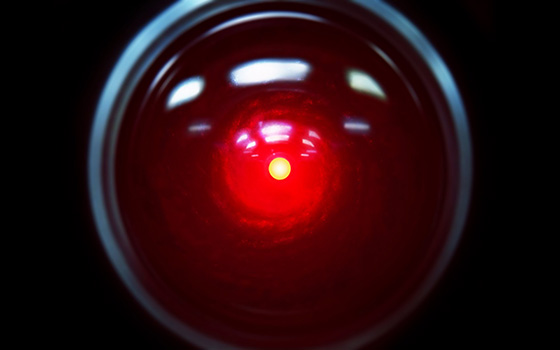
An alien message in Arrival movie (dredit: Paramount Pictures)
By Susan Schneider
Humans are probably not the greatest intelligences in the universe.
Earth is a relatively young planet and the oldest civilizations could be
billions of years older than us. But even on Earth,
Homo sapiens may not be the most intelligent species for that much longer.
The world Go, chess, and
Jeopardy champions are now all AIs.
AI is projected to outmode many human professions within the next few
decades. And given the rapid pace of its development, AI may soon
advance to artificial general intelligence—intelligence that, like human
intelligence, can combine insights from different topic areas and
display flexibility and common sense. From there it is a short leap to
superintelligent AI, which is smarter than humans in every respect, even
those that now seem firmly in the human domain, such as scientific
reasoning and social skills. Each of us alive today may be one of the
last rungs on the evolutionary ladder that leads from the first living
cell to synthetic intelligence.
What we are only beginning to realize is that these two forms of
superhuman intelligence—alien and artificial—may not be so distinct. The
technological developments we are witnessing today may have all
happened before, elsewhere in the universe. The transition from
biological to synthetic intelligence may be a general pattern,
instantiated over and over, throughout the cosmos. The universe’s
greatest intelligences may be postbiological, having grown out of
civilizations that were once biological. (This is a view I share with
Paul Davies, Steven Dick, Martin Rees, and Seth Shostak, among others.)
To judge from the human experience—the only example we have—the
transition from biological to postbiological may take only a few hundred
years.
I prefer the term “postbiological” to “artificial” because the
contrast between biological and synthetic is not very sharp. Consider a
biological mind that achieves superintelligence through purely
biological enhancements, such as nanotechnologically enhanced neural
minicolumns. This creature would be postbiological, although perhaps
many wouldn’t call it an “AI.” Or consider a computronium that is built
out of purely biological materials, like the Cylon Raider in the
reimagined
Battlestar Galactica TV series.
The key point is that there is no reason to expect humans to be the
highest form of intelligence there is. Our brains evolved for specific
environments and are greatly constrained by chemistry and historical
contingencies. But technology has opened up a vast design space,
offering new materials and modes of operation, as well as new ways to
explore that space at a rate much faster than traditional biological
evolution. And I think we already see reasons why synthetic intelligence
will outperform us.
An extraterrestrial AI could have goals that conflict with those of biological life
Silicon microchips already seem to be a better medium for information
processing than groups of neurons. Neurons reach a peak speed of about
200 hertz, compared to gigahertz for the transistors in current
microprocessors. Although the human brain is still far more intelligent
than a computer, machines have almost unlimited room for improvement. It
may not be long before they can be engineered to match or even exceed
the intelligence of the human brain through reverse-engineering the
brain and improving upon its algorithms, or through some combination of
reverse engineering and judicious algorithms that aren’t based on the
workings of the human brain.
In addition, an AI can be downloaded to multiple locations at once,
is easily backed up and modified, and can survive under conditions that
biological life has trouble with, including interstellar travel. Our
measly brains are limited by cranial volume and metabolism;
superintelligent AI, in stark contrast, could extend its reach across
the Internet and even set up a Galaxy-wide computronium, utilizing all
the matter within our galaxy to maximize computations. There is simply
no contest. Superintelligent AI would be far more durable than us.
Suppose I am right. Suppose that intelligent life out there is
postbiological. What should we make of this? Here, current debates over
AI on Earth are telling. Two of the main points of contention—the
so-called control problem and the nature of subjective experience—affect
our understanding of what other alien civilizations may be like, and
what they may do to us when we finally meet.
Ray Kurzweil takes an optimistic view of the postbiological phase of
evolution, suggesting that humanity will merge with machines, reaching a
magnificent technotopia. But Stephen Hawking, Bill Gates, Elon Musk,
and others have expressed the concern that humans could lose control of
superintelligent AI, as it can rewrite its own programming and outthink
any control measures that we build in. This has been called the “control
problem”—the problem of how we can control an AI that is both
inscrutable and vastly intellectually superior to us.

“I’m
sorry, Dave” — HAL in 2001: A Space Odyssey. If you think intelligent
machines are dangerous, imagine what intelligent extraterrestrial
machines could do. (credit: YouTube/Warner Bros.)
Superintelligent AI could be developed during a technological
singularity, an abrupt transition when ever-more-rapid technological
advances—especially an intelligence explosion—slip beyond our ability to
predict or understand. But even if such an intelligence arises in less
dramatic fashion, there may be no way for us to predict or control its
goals. Even if we could decide on what moral principles to build into
our machines, moral programming is difficult to specify in a foolproof
way, and such programming could be rewritten by a superintelligence in
any case. A clever machine could bypass safeguards, such as kill
switches, and could potentially pose an existential threat to biological
life. Millions of dollars are pouring into organizations devoted to AI
safety. Some of the finest minds in computer science are working on this
problem. They will hopefully create safe systems, but many worry that
the control problem is insurmountable.
In light of this, contact with an alien intelligence may be even more
dangerous than we think. Biological aliens might well be hostile, but
an extraterrestrial AI could pose an even greater risk. It may have
goals that conflict with those of biological life, have at its disposal
vastly superior intellectual abilities, and be far more durable than
biological life.
That argues for caution with so-called Active SETI, in which we do
not just passively listen for signals from other civilizations, but
deliberately advertise our presence. In the most famous example, in 1974
Frank Drake and Carl Sagan used the giant dish-telescope in Arecibo,
Puerto Rico, to send a message to a star cluster. Advocates of Active
SETI hold that, instead of just passively listening for signs of
extraterrestrial intelligence, we should be using our most powerful
radio transmitters, such as Arecibo, to send messages in the direction
of the stars that are nearest to Earth.
Why would nonconscious machines have the same value we place on biological intelligence?
Such a program strikes me as reckless when one considers the control
problem. Although a truly advanced civilization would likely have no
interest in us, even one hostile civilization among millions could be
catastrophic. Until we have reached the point at which we can be
confident that superintelligent AI does not pose a threat to us, we
should not call attention to ourselves. Advocates of Active SETI point
out that our radar and radio signals are already detectable, but these
signals are fairly weak and quickly blend with natural galactic noise.
We would be playing with fire if we transmitted stronger signals that
were intended to be heard.
The safest mindset is intellectual humility. Indeed, barring
blaringly obvious scenarios in which alien ships hover over Earth, as in
the recent film
Arrival, I wonder if we could even
recognize the technological markers of a truly advanced
superintelligence. Some scientists project that superintelligent AIs
could feed off black holes or create Dyson Spheres, megastructures that
harnesses the energy of entire stars. But these are just speculations
from the vantage point of our current technology; it’s simply the height
of hubris to claim that we can foresee the computational abilities and
energy needs of a civilization millions or even billions of years ahead
of our own.
Some of the first superintelligent AIs could have cognitive systems
that are roughly modeled after biological brains—the way, for instance,
that deep learning systems are roughly modeled on the brain’s neural
networks. Their computational structure might be comprehensible to us,
at least in rough outlines. They may even retain goals that biological
beings have, such as reproduction and survival.
But superintelligent AIs, being self-improving, could quickly morph
into an unrecognizable form. Perhaps some will opt to retain cognitive
features that are similar to those of the species they were originally
modeled after, placing a design ceiling on their own cognitive
architecture. Who knows? But without a ceiling, an alien
superintelligence could quickly outpace our ability to make sense of its
actions, or even look for it. Perhaps it would even blend in with
natural features of the universe; perhaps it is in dark matter itself,
as Caleb Scharf recently speculated.

The Arecibo message was broadcast into space a single time, for 3 minutes, in November 1974 (credit: SETI Institute)
An advocate of Active SETI will point out that this is precisely why
we should send signals into space—let them find us, and let them design
means of contact they judge to be tangible to an intellectually inferior
species like us. While I agree this is a reason to consider Active
SETI, the possibility of encountering a dangerous superintelligence
outweighs it. For all we know, malicious superintelligences could infect
planetary AI systems with viruses, and wise civilizations build
cloaking devices. We humans may need to reach our own singularity before
embarking upon Active SETI. Our own superintelligent AIs will be able
to inform us of the prospects for galactic AI safety and how we would go
about recognizing signs of superintelligence elsewhere in the universe.
It takes one to know one.
It is natural to wonder whether all this means that humans should
avoid developing sophisticated AI for space exploration; after all,
recall the iconic HAL in
2001: A Space Odyssey. Considering a
future ban on AI in space would be premature, I believe. By the time
humanity is able to investigate the universe with its own AIs, we humans
will likely have reached a tipping point. We will have either already
lost control of AI—in which case space projects initiated by humans will
not even happen—or achieved a firmer grip on AI safety. Time will tell.
Raw intelligence is not the only issue to worry about. Normally, we
expect that if we encountered advanced alien intelligence, we would
likely encounter creatures with very different biologies, but they would
still have minds like ours in an important sense—there would be
something it is like, from the inside, to be them. Consider that every
moment of your waking life, and whenever you are dreaming, it feels like
something to be
you. When you see the warm hues of a sunrise,
or smell the aroma of freshly baked bread, you are having conscious
experience. Likewise, there is also something that it is like to be an
alien—or so we commonly assume. That assumption needs to be questioned
though. Would superintelligent AIs even have conscious experience and,
if they did, could we tell? And how would their inner lives, or lack
thereof, impact us?
The question of whether AIs have an inner life is key to how we value
their existence. Consciousness is the philosophical cornerstone of our
moral systems, being key to our judgment of whether someone or something
is a self or person rather than a mere automaton. And conversely,
whether they are conscious may also be key to how they value
us.
The value an AI places on us may well hinge on whether it has an inner
life; using its own subjective experience as a springboard, it could
recognize in us the capacity for conscious experience. After all, to the
extent we value the lives of other species, we value them because we
feel an affinity of consciousness—thus most of us recoil from killing a
chimp, but not from munching on an apple.
But how can beings with vast intellectual differences and that are
made of different substrates recognize consciousness in each other?
Philosophers on Earth have pondered whether consciousness is limited to
biological phenomena. Superintelligent AI, should it ever wax
philosophical, could similarly pose a “problem of biological
consciousness” about us, asking whether we have the right stuff for
experience.
Who knows what intellectual path a superintelligence would take to
tell whether we are conscious. But for our part, how can we humans tell
whether an AI is conscious? Unfortunately, this will be difficult. Right
now, you can tell you are having experience, as it feels like something
to be
you. You are your own paradigm case of conscious
experience. And you believe that other people and certain nonhuman
animals are likely conscious, for they are neurophysiologically similar
to you. But how are you supposed to tell whether something made of a
different substrate can have experience?

Westworld (credit: HBO)
Consider, for instance, a silicon-based superintelligence. Although
both silicon microchips and neural minicolumns process information, for
all we now know they could differ molecularly in ways that impact
consciousness. After all, we suspect that carbon is chemically more
suitable to complex life than silicon is. If the chemical differences
between silicon and carbon impact something as important as life itself,
we should not rule out the possibility that the chemical differences
also impact other key functions, such as whether silicon gives rise to
consciousness.
The conditions required for consciousness are actively debated by AI
researchers, neuroscientists, and philosophers of mind. Resolving them
might require an empirical approach that is informed by philosophy—a
means of determining, on a case-by-case basis, whether an
information-processing system supports consciousness, and under what
conditions.
Here’s a suggestion, a way we can at least enhance our understanding
of whether silicon supports consciousness. Silicon-based brain chips are
already under development as a treatment for various memory-related
conditions, such as Alzheimer’s and post-traumatic stress disorder. If,
at some point, chips are used in areas of the brain responsible for
conscious functions, such as attention and working memory, we could
begin to understand whether silicon is a substrate for consciousness. We
might find that replacing a brain region with a chip causes a loss of
certain experience, like the episodes that Oliver Sacks wrote about.
Chip engineers could then try a different, non-neural, substrate, but
they may eventually find that the only “chip” that works is one that is
engineered from biological neurons. This procedure would serve as a
means of determining whether artificial systems can be conscious, at
least when they are placed in a larger system that we already believe is
conscious.
Even if silicon can give rise to consciousness, it might do so only
in very specific circumstances; the properties that give rise to
sophisticated information processing (and which AI developers care
about) may not be the same properties that yield consciousness.
Consciousness may require
consciousness engineering—a deliberate engineering effort to put consciousness in machines.
Here’s my worry. Who, on Earth or on distant planets, would aim to
engineer consciousness into AI systems themselves? Indeed, when I think
of existing AI programs on Earth, I can see certain reasons why AI
engineers might actively
avoid creating conscious machines.
Robots are currently being designed to take care of the elderly in
Japan, clean up nuclear reactors, and fight our wars. Naturally, the
question has arisen: Is it ethical to use robots for such tasks if they
turn out to be conscious? How would that differ from breeding humans for
these tasks? If I were an AI director at Google or Facebook, thinking
of future projects, I wouldn’t want the ethical muddle of inadvertently
designing a sentient system. Developing a system that turns out to be
sentient could lead to accusations of robot slavery and other
public-relations nightmares, and it could even lead to a ban on the use
of AI technology in the very areas the AI was designed to be used in. A
natural response to this is to seek architectures and substrates in
which robots are not conscious.
Further, it may be more efficient for a self-improving
superintelligence to eliminate consciousness. Think about how
consciousness works in the human case. Only a small percentage of human
mental processing is accessible to the conscious mind. Consciousness is
correlated with novel learning tasks that require attention and focus. A
superintelligence would possess expert-level knowledge in every domain,
with rapid-fire computations ranging over vast databases that could
include the entire Internet and ultimately encompass an entire galaxy.
What would be novel to it? What would require slow, deliberative focus?
Wouldn’t it have mastered everything already? Like an experienced driver
on a familiar road, it could rely on nonconscious processing. The
simple consideration of efficiency suggests, depressingly, that the most
intelligent systems will not be conscious. On cosmological scales,
consciousness may be a blip, a momentary flowering of experience before
the universe reverts to mindlessness.
If people suspect that AI isn’t conscious, they will likely view the
suggestion that intelligence tends to become postbiological with dismay.
And it heightens our existential worries. Why would nonconscious
machines have the same value we place on biological intelligence, which
is conscious?
Soon, humans will no longer be the measure of intelligence on Earth.
And perhaps already, elsewhere in the cosmos, superintelligent AI, not
biological life, has reached the highest intellectual plateaus. But
perhaps biological life is distinctive in another significant
respect—conscious experience. For all we know, sentient AI will require a
deliberate engineering effort by a benevolent species, seeking to
create machines that feel. Perhaps a benevolent species will see fit to
create their own AI mindchildren. Or perhaps future humans will engage
in some consciousness engineering, and send sentience to the stars.
SUSAN SCHNEIDER is an associate professor of philosophy and
cognitive science at the University of Connecticut and an affiliated
faculty member at the Institute for Advanced Study, the Center of
Theological Inquiry, YHouse, and the Ethics and Technology Group at
Yale’s Interdisciplinary Center of Bioethics. She has written several
books, including Science Fiction and Philosophy: From Time Travel to Superintelligence
. For more information, visit SchneiderWebsite.com.








